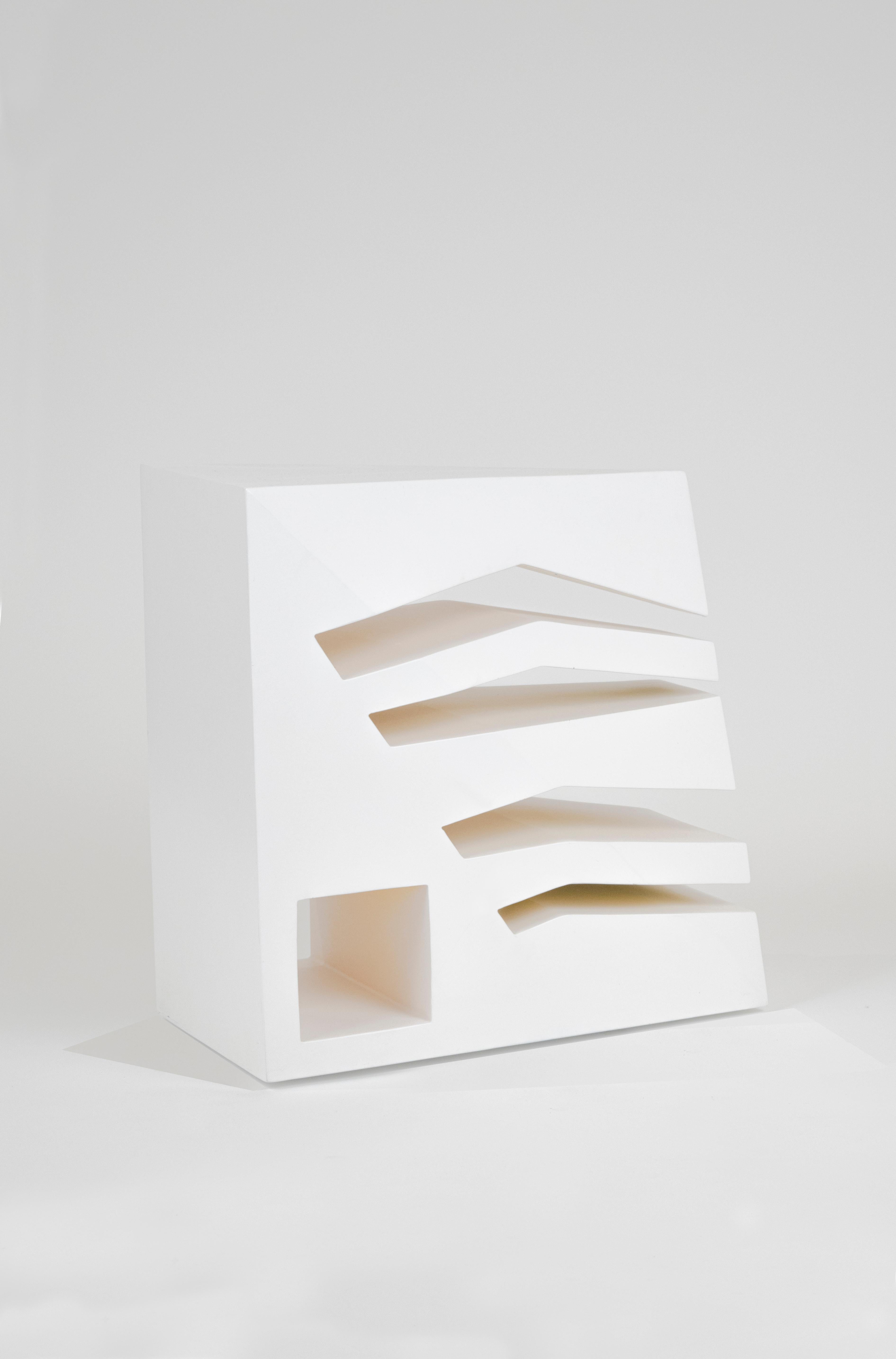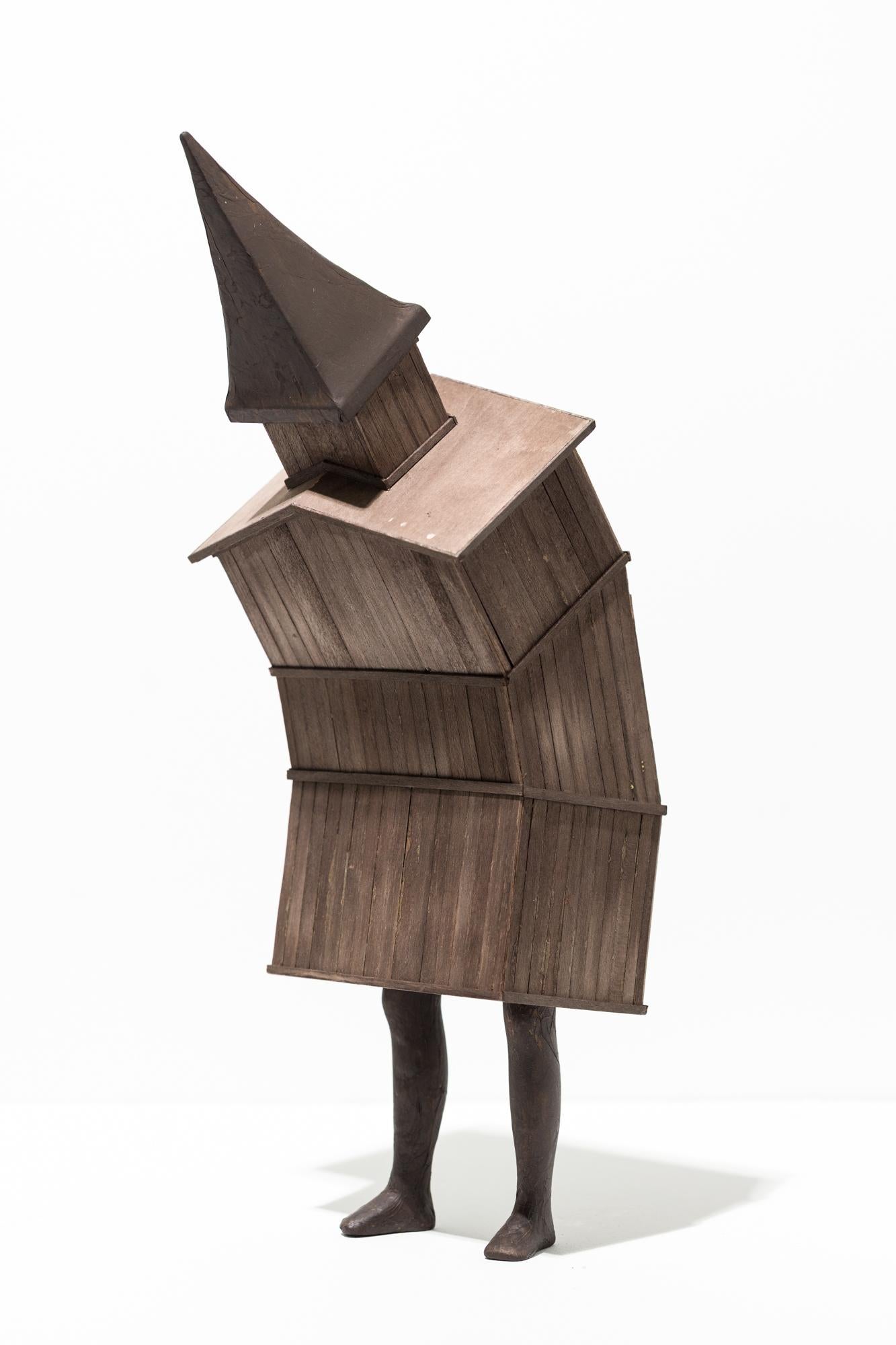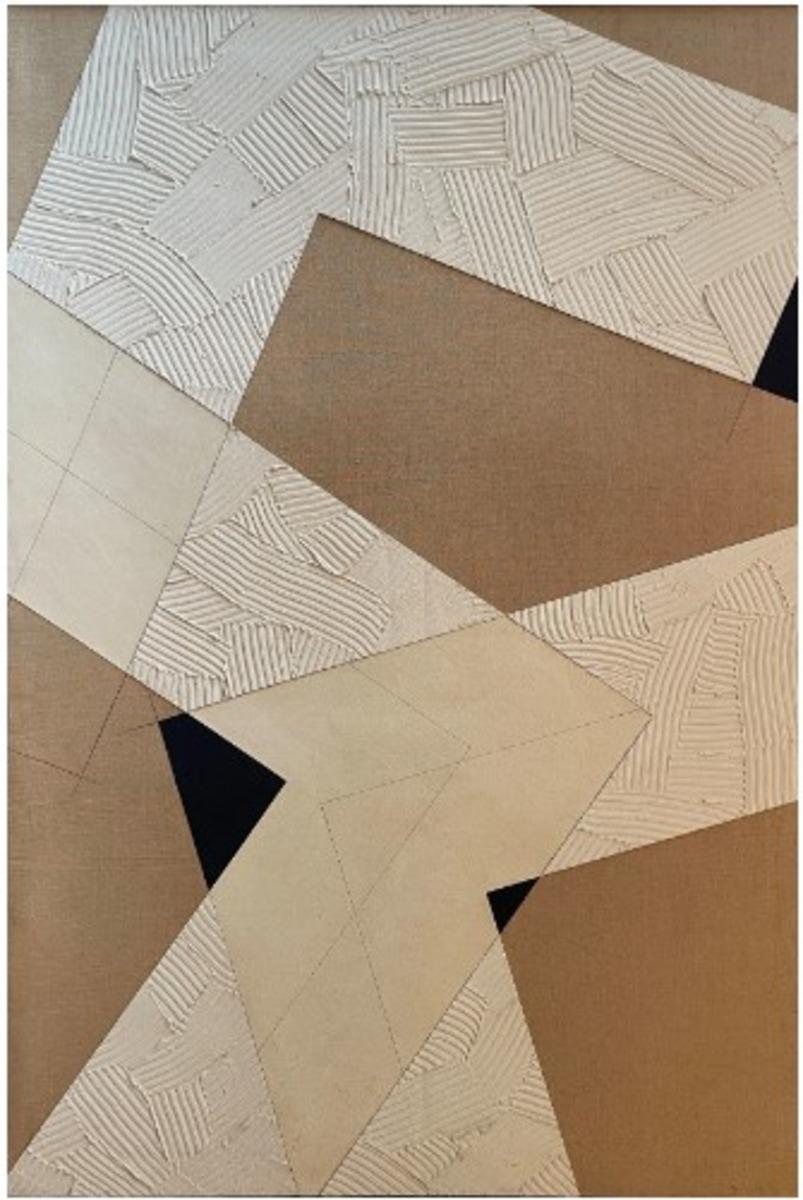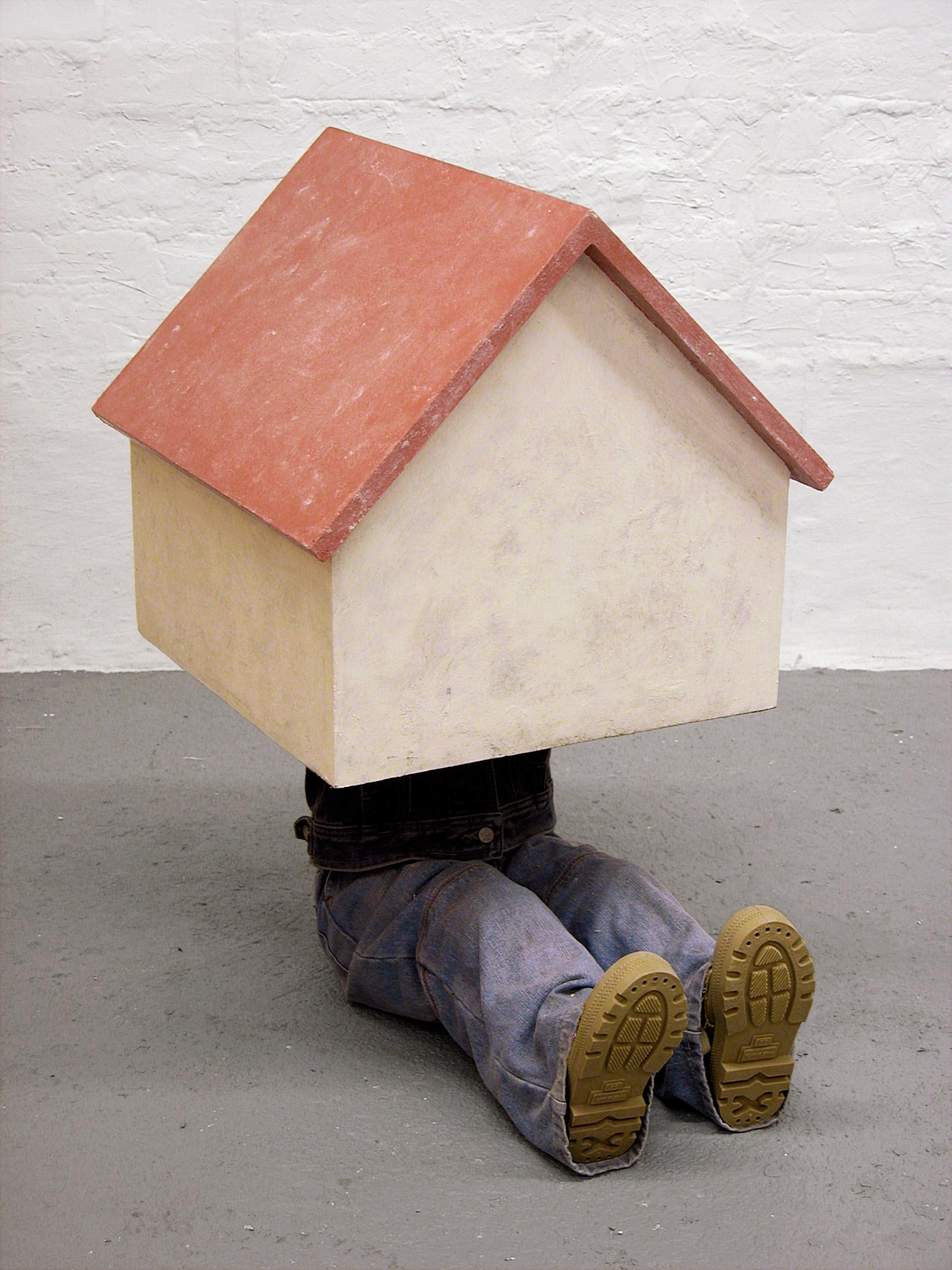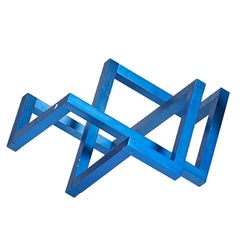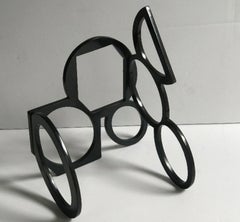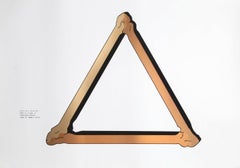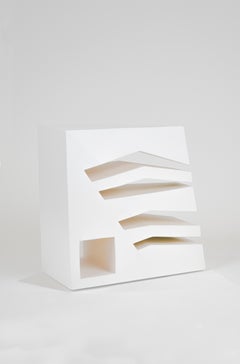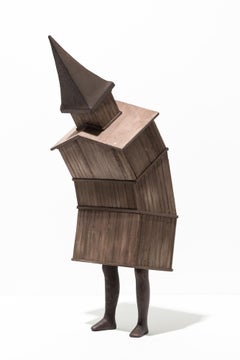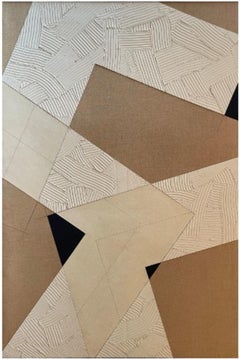Items Similar to House in Motion
Want more images or videos?
Request additional images or videos from the seller
1 of 7
Buky SchwartzHouse in Motion1986
1986
$7,000
£5,297.92
€6,080.47
CA$9,972.08
A$10,814.96
CHF 5,680.43
MX$131,366
NOK 71,081.56
SEK 66,927.25
DKK 45,414.29
About the Item
Buky Schwartz
House in Motion, 1986
Welded steel
10 1/2 × 6 1/4 × 6 1/2 inches
This is a unique work
The sculpture is an upside down house with two human figures. It is ingeniously designed, which can be appreciated when the sculpture is moved around to reveal a different perspective of the house from each angle. The house in motion, or upside down home can be appreciated both literally and metaphorically. This is a very special sculpture and it entirely unique.
Buky Schwartz was born in Jerusalem and originally trained as a sculptor in Israel, Schwartz moved to London in 1959, where he played an important role in the hotbed of new sculptural directions at St. Martin’s School of Art during the 1960s. in 1971 Schwartz moved to New York, where he continued to reside part of each year. During the 1960s and 1970s Schwartz’s inventive use of sculptural materials, such as mirrors and wooden timbers, involved an interplay between illusory appearances and the actual, physical presence, weight, and structure of his work. This playful interaction between sculptural appearance and physical reality quickly became a central aspect in much of his video installation work as he added that modern medium to his vocabulary in the late 1970s.
Schwartz’s video constructions have been essentially of two types: objects, sculptural presences that incorporate video monitors and around which the viewer moves; and environments, which are akin to architectural interiors in that the viewer is surrounded by forms and colors, including closed-circuit video imagery.
Schwartz’s creative use of the electronic medium of video, and the complex and emphatic manner in which he integrates the viewer into his video work, are both related to central aspects of twentieth-century art. Thus Schwartz’s work is of interest not simply for itself, but for its place in modern art as well.
Acclaimed in three worlds – Europe, Israel, and the United States – Schwartz’s work has been included in the Venice Biennale (1966), the Whitney Biennial (1981) in New York, the Carnegie International (1982) in Pittsburgh, and Documenta (1987) in Kassel. He was also represented in such leading historical surveys of video art as A History of Video Art (1984) at the Museum of Modern Art, New York, and Video Skulptur (1989), Cologne. His work has had numerous presentations in one-person and group exhibitions at galleries and museums throughout the world and is included in several private and public collections, most notably: Whitney Museum, N.Y.C, Guggenheim Museum, N.Y.C, and Smithsonian American Art Museum, Washington DC.
Not signed
Very good with minor scratching and wear to the metal; it also has a bit of rust and tape on the base. (See Photos)
- Creator:Buky Schwartz (1932 - 2009, Israeli, American)
- Creation Year:1986
- Dimensions:Height: 10.5 in (26.67 cm)Width: 6.25 in (15.88 cm)Depth: 6.5 in (16.51 cm)
- Medium:
- Movement & Style:
- Period:
- Condition:Very good with minor scratching and wear to the metal; it also has a bit of rust and tape on the base. (See Photos).
- Gallery Location:New York, NY
- Reference Number:1stDibs: LU1745212636762
About the Seller
5.0
Gold Seller
Premium sellers maintaining a 4.3+ rating and 24-hour response times
Established in 2007
1stDibs seller since 2022
455 sales on 1stDibs
Typical response time: 2 hours
- ShippingRetrieving quote...Shipping from: New York, NY
- Return Policy
Authenticity Guarantee
In the unlikely event there’s an issue with an item’s authenticity, contact us within 1 year for a full refund. DetailsMoney-Back Guarantee
If your item is not as described, is damaged in transit, or does not arrive, contact us within 7 days for a full refund. Details24-Hour Cancellation
You have a 24-hour grace period in which to reconsider your purchase, with no questions asked.Vetted Professional Sellers
Our world-class sellers must adhere to strict standards for service and quality, maintaining the integrity of our listings.Price-Match Guarantee
If you find that a seller listed the same item for a lower price elsewhere, we’ll match it.Trusted Global Delivery
Our best-in-class carrier network provides specialized shipping options worldwide, including custom delivery.More From This Seller
View AllGeometric abstraction mid century modern constructivist Signed metal sculpture
Located in New York, NY
Forrest Myers
Untitled geometric abstraction, 1976
Painted aluminum
Signed in the metal with the artist's incised initials (FM) and stamp numbered 52/75; bears Treitel-Gratz foundry ...
Category
1970s Constructivist Abstract Sculptures
Materials
Metal
1960s Constructivist/Minimalist Sculpture hand signed and dated and stamp signed
Located in New York, NY
Lyman Kipp
1960s Constructivist/Minimalist Sculpture, 1968
Painted Wood
Signed twice: signed and dated 1968 in black marker on the underside also bears artist's official name and dat...
Category
1960s Minimalist Abstract Sculptures
Materials
Wood, Paint
Rydbo Maquette, 1989-2000, unique geometric sculpture by renowned British artist
By Nigel Hall
Located in New York, NY
NIGEL HALL
Rydbo Maquette, 1989-2000
Painted Steel
Unique
The authenticity of this work has been confirmed by the artist
Provenance:
Christie's New York: J...
Category
Early 2000s Minimalist Abstract Sculptures
Materials
Steel
Study for Sculpture by important Minimalist sculptor geometric abstraction
By Robert Morris
Located in New York, NY
Robert Morris (1931-2018)
Study for Copper Sculpture, 1980
Screenprint with Metallic Ink, signed and numbered in pencil
Pencil signed, dated, and numbered PP1/7 by Robert Morris on t...
Category
1980s Minimalist Abstract Prints
Materials
Ink, Screen
Maquette for Laureate (unique sculpture)
By Seymour Lipton
Located in New York, NY
Seymour Lipton
Maquette for Laureate, ca. 1968-1969
Nickel silver on monel metal
Unique
18 × 8 1/2 × 7 inches
Marlborough-Gerson Gallery, New York
Acquired from the above by the previous owner, 1969
thence by descent
Christie's New York: Monday, June 30, 2008 [Lot 00199]
Acquired from the above Christie's sale This unique sculpture by important Abstract Expressionist sculptor Seymour Lipton is a maquette of the monumental sculpture "Laureate" - one of Lipton's most iconic and influential works located on the Riverwalk in downtown Milwaukee, Wisconsin. Laureate is a masterpiece that was commissioned by the Allen-Bradley Company in memory of Harry Lynde Bradley and as an enhancement for the newly constructed Performing Arts Center. It is located on the east bank of the Milwaukee River at 929 North Water Street. The Bradley family in Milwaukee were renowned patrons of modernist sculpture, known for their excellent taste who also founded an eponymous sculpture park. For reference only is an image of the monumental "Laureate" one of Milwaukee's most beloved public sculptures. According to the Smithsonian, which owns a different unique variation of this work, "The full-size sculpture Laureate was commissioned by the Marcus Center for the Performing Arts in Milwaukee. In the initial drawings, Seymour Lipton combined details from the architectural plan with a wide variety of images, ranging from musical instruments to a lighthouse on the island of Tobago. He transformed the basic shapes from these sketches into a welded sculpture, which evokes a figure composed of columns, harp strings, and coiled rope. Lipton created this piece to celebrate achievement in the arts. The dramatic silhouette commands your attention, reflecting the title Laureate, which means worthy of honor and distinction. The final version of the piece is over twelve feet high and stands out against the pale, flat buildings of the arts center.,,"
Provenance
Marlborough-Gerson Gallery, New York
Acquired from the above by the previous owner, 1969
thence by descent
Christie's New York: Monday, June 30, 2008 [Lot 00199]
Acquired from the above Christie's sale
About Seymour Lipton:
Born in New York City in 1903, Seymour Lipton (1903-1986) grew up in a Bronx tenement at a time when much of the borough was still farmland. These rural surroundings enabled Lipton to explore the botanical and animal forms that would later become sources for his work. Lipton’s interest in the dialogue between artistic creation and natural phenomena was nurtured by a supportive family and cultivated through numerous visits to New York’s Museum of Natural History as well as its many botanical gardens and its zoos. In the early 1920s, with the encouragement of his family, Lipton studied electrical engineering at Brooklyn Polytechnic Institute and pursued a liberal arts education at City College. Ultimately, like fellow sculptor Herbert Ferber, Lipton became a dentist, receiving his degree from Columbia University in 1927. In the late 1920s, he began to explore sculpture, creating clay portraits of family members and friends.
In addition to providing him with financial security, dentistry gave Lipton a foundation in working with metal, a material he would later use in his artwork. In the early 1930s, though, Lipton’s primary sculptural medium was wood. Lipton led a comfortable life, but he was also aware of the economic and psychological devastation the Depression had caused New York. In response, he generally worked using direct carving techniques—a form of sculpting where the artist “finds” the sculpture within the wood in the process of carving it and without the use of models and maquettes. The immediacy of this practice enabled Lipton to create a rich, emotional and visual language with which to articulate the desperation of the downtrodden and the unwavering strength of the disenfranchised. In 1935, he exhibited one such early sculpture at the John Reed Club Gallery in New York, and three years later, ACA Gallery mounted Lipton’s first solo show, which featured these social-realist-inspired wooden works. In 1940, this largely self-taught artist began teaching sculpture at the New School for Social Research, a position he held until 1965.
In the 1940s, Lipton began to devote an increasing amount of time to his art, deviating from wood and working with brass, lead, and bronze. Choosing these metals for their visual simplicity, which he believed exemplified the universal heroism of the “everyman,” Lipton could also now explore various forms of abstraction. Lipton’s turn towards increasing abstraction in the 1940s allowed him to fully develop his metaphorical style, which in turn gave him a stronger lexicon for representing the horrors of World War II and questioning the ambiguities of human experience. He began his metal work with cast bronze sculptures, but, in 1946, he started welding sheet metal and lead. Lipton preferred welding because, as direct carving did with wood, this approach allowed “a more direct contact with the metal.”[ii] From this, Lipton developed the technique he would use for the remainder of his career: “He cut sheet metal, manipulated it to the desired shapes, then joined, soldered, or welded the pieces together. Next, he brazed a metal coating to the outside to produce a uniform texture.”[iii]
In 1950, Lipton arrived at his mature style of brazing on Monel metal. He also began to draw extensively, exploring the automatism that abstract expressionist painters were boasting at the time. Like contemporaries such as Jackson Pollock, Lipton was strongly influenced by Carl Jung’s work on the unconscious mind and the regenerative forces of nature. He translated these two-dimensional drawings into three-dimensional maquettes that enabled him to revise his ideas before creating the final sculpture.The forms that Lipton produced during this period were often zoomorphic, exemplifying the tension between the souls of nature and the automatism of the machine.
In the years following the 1950s, Lipton’s optimism began to rise, and the size of his work grew in proportion. The oxyacetylene torch—invented during the Second World War—allowed him to rework the surfaces of metal sculptures, thus eliminating some of the risks involved with producing large-scale finished works. In 1958, Lipton was awarded a solo exhibition at the Venice Biennale and was thus internationally recognized as part of a small group of highly regarded avant-garde constructivist sculptors. In 1960, he received a prestigious Guggenheim Award, which was followed by several prominent public commissions, including his heroic Archangel, currently residing in Lincoln Center’s David Geffen Hall.
A number of important solo exhibitions of his work followed at The Phillips Collection in Washington, DC (1964); the Milwaukee Art Center and University of Wisconsin, Milwaukee (1969); the Virginia Museum of Fine Arts in Richmond (1972); the Everson Museum in Syracuse, NY (1973); the Herbert E. Johnson Museum of Art of Cornell University in Ithaca, NY (1973); the National Collection of Fine Arts, Smithsonian Institution (now the Smithsonian American Art Museum) in Washington, DC (1978); and a retrospective in 1979 at The Jewish Museum in New York. In 1982 and 1984 alone, two exhibitions of his sculpture, organized respectively by the Mint Museum (Charlotte, NC) and the Hillwood Art Gallery of Long Island University (Greenvale, NY), traveled extensively across museums and university galleries around the nation. In 2000, the traveling exhibition An American Sculptor: Seymour Lipton was first presented by the Palmer Museum of Art of Pennsylvania State University in University Park. Most recently, in 2009, the Ackland Art Museum in Chapel Hill, NC mounted The Guardian and the Avant-Garde: Seymour Lipton’s Sentinel II in Context.
Since 2004, Michael Rosenfeld Gallery has been the exclusive representative of the Estate of Seymour Lipton and has presented two solo exhibitions of his work—Seymour Lipton: Abstract Expressionist Sculptor (2005) and Seymour Lipton: Metal (2008). In 2013, Michael Rosenfeld Gallery presented Abstract Expressionism, In Context: Seymour Lipton, which included twelve major sculptures by the artist, along with works by Charles Alston, Norman Bluhm, Beauford Delaney, Willem de Kooning, Jay DeFeo, Michael Goldberg, Adolph Gottlieb, Hans Hofmann, Lee Krasner, Norman Lewis, Conrad Marca-Relli, Boris Margo, Alfonso Ossorio, Richard Pousette-Dart, Milton Resnick, Charles Seliger...
Category
1960s Abstract Expressionist Abstract Sculptures
Materials
Metal, Silver
Uxmal, unique bronze sculpture by Greek-American sculptor and Harvard professor
Located in New York, NY
Dimitri Hadzi
Uxmal, 1991
Cast bronze on custom made granite base
17 × 30 1/2 × 14 inches
The title UXMAL, refers to the ancient Mayan city of Uxmal, which is known for its "Pyramid of the Magician"
Provenance:
Acquired by the original owner from the prestigious Gremillion Gallery in Houston, Texas (accompanied by a copy of the original receipt)
Measurements:
Base:
26.5 by 11 by 1.75 inches
Work longest
30.5 inches
Widest 14 inches
Highest. 17 inches
More about Dimitri Hadzi"
Derived from the figure and mythic narratives, Hadzi’s sculpture references antiquity and classical artifacts – abstracted anatomical forms, columnar and other architectural elements, helmets, weaponry and body armor function as visual metaphors for ancient cultures. “I was interested in mythology, and I was interested in movement,” Hadzi remarked on his years in Rome, “I was attempting through formal methods to exaggerate sexual tension or apprehension. Suddenly I was myself in an atmosphere of freedom.” [1] Powerfully rendered in bronze his sculptures convey raw emotion, brute strength and mass, tempered with a delicate rush of whimsy, vivacity and sensuality.
Born in New York City on March 21, 1921, Hadzi graduated from Cooper Union in 1950 and received a Fulbright Fellowship in the same year. After studying sculpture in Greece, he moved to Rome under the GI Bill where he lived for twenty-five years. Hadzi returned to the U.S. where he taught at Harvard University for fourteen years. He continued to create sculpture until his death in 2006.
Hadzi is included in the permanent collections of the Museum of Modern Art; the Whitney Museum of American Art; the Museum of Fine Arts, Boston; the Hirshhorn Museum and Sculpture Garden; The Phillips Collection and the Guggenheim Museum. Receiving over twenty sculpture commissions, Hadzi’s work appears in public squares, concert halls, federal and private plazas, and universities throughout the world.
---------------
[1] Elsen, Albert. “On Artistic Freedom: An Interview,” Dimitri Hadzi, (New York: Hudson Hills Press, 1996), 30.
Additional Biography:
Dimitri Hadzi (1921 – 2006) is among the most distinguished modernist sculptors, creator of works in bronze and stone that are powerfully abstract and expressionist in character. His contribution to the international language of sculpture continues to influence and inspire through permanent installations and collections, and exhibitions worldwide.
Born to Greek-American immigrant parents in New York City, he had a talent for drawing at an early age and won a prize for his young ability. But, it wasn't until after serving in the Air-force in the South Pacific during WWII that he turned his sights fully to painting and sculpture, going on to study both at Cooper Union. Eventually, he would become a mainstay of the Cambridge, MA art community. He was a Guggenheim Fellow (1957), the winner of the Venice Biennale Award (1962), and the Rome Prize (1974).
His most notable sculptures are: Copley Place Waterfall (Boston, MA), Owen Glass Co. (Toledo, OH), as well as Thermopolis, adjacent to Boston’s City Hall Plaza, and the former Omphalos in Harvard Square (Cambridge, MA).
Hadzi is included in the permanent collections of the Museum of Modern Art; National Gallery of Art; Whitney Museum of American Art; Museum of Fine Art, Boston; Hirshhorn Museum and Sculpture Garden; The Phillips Collection and the Guggenheim Museum.
Additionally, Hadzi was also a prolific painter, and printmaker. He also taught at Harvard University for over a decade. Famously, David Hockney attended one of Hadzi’s classes at the Carpenter Center at Harvard, where Hadzi served as director. The two of them spent time together painting and discussing techniques. Hockney gifted Hadzi one of his paintings.
He worked alongside his good friend, Nobel Prize winning Irish poet...
Category
1990s Abstract Abstract Sculptures
Materials
Granite, Bronze
You May Also Like
Cuadrado Diagonal - 21st Century, Contemporary Art, Abstract Sculpture, Iron
By Daniel Suárez
Located in Barcelona, Catalonia
Technique: Painted iron
"His works, far from imposing, negotiate with the environment. And this exchange is possible because there is a correspondence of properties between one and ...
Category
21st Century and Contemporary Contemporary Abstract Sculptures
Materials
Iron
"Neighborling Maquette 30" Personified House Structure as Tabletop Sculpture
By Seth Clark
Located in Philadelphia, PA
This piece, titled "Neighborling Maquette 30" is an original free-standing sculpture by Seth Clark as part of his newest solo exhibition, "Passing Through". Clark's deteriorating st...
Category
21st Century and Contemporary Contemporary Figurative Sculptures
Materials
Wood, Paper, Acrylic, Resin
"Villa Adrienne #17" Georges Noel, Constructivist, Architectural
By Georges Noel
Located in New York, NY
Georges Noel
Villa Adrienne #17, 1976
Graphite, pigment, sand, and vinyl binder on canvas
Signed to verso
76 3/4 x 51 inches
The Pace Gallery label to verso
With restless strokes ...
Category
1970s Assemblage Mixed Media
Materials
Canvas, Vinyl, Graphite, Pigment
$23,200 Sale Price
20% Off
Equilibrio Arquitectonico III, 2009
Located in Atlanta, GA
The painter and sculptor Martín Carral studied Fine Arts at the University of Barcelona. Carral has been painting gravitational waves for many years, an ...
Category
21st Century and Contemporary Modern Abstract Sculptures
Materials
Mixed Media
A Doll House, Mixed Media Figurative Sculpture
By Hans Van Meeuwen
Located in Boston, MA
A Doll House, Mixed Media Figurative Sculpture by Dutch artist Hans Van Meeuwen.
Artist Commentary:
Pars pro toto. A part of the whole, leaving the v...
Category
21st Century and Contemporary Abstract Abstract Sculptures
Materials
Fabric, Fiberglass, Wood, Mixed Media
Geometric Composition - Sculpture by Giuseppe Pulvirenti - 1984
Located in Roma, IT
Geometric Composition is a sculpture realized in 1984 by Giuseppe Pulvirenti (Siracusa, Sicily, 1959).
Made in Italy.
Steel.
Signed and dated: G. Pulvirenti 84.
The sculpture de...
Category
1980s Modern Figurative Sculptures
Materials
Metal
More Ways To Browse
Salvador Dali Ceramic
Salvador Dali Tile
Silver Sculpture Salvador Dali
Sima Josef
Spray Paint Can Sculpture
Stanislaw Wysocki
Susan Kemenyffy
Taller Alfonso Castillo Orta
Tete De Chevre De Profil
Thalia Sculpture
Waldo Peirce
Yves Klein Pompon
16th Century Wood Angel
Albert Toft
Apple Fiberglass
Aquila Van Der Kant
Arman Saxophone
Arman Venus
